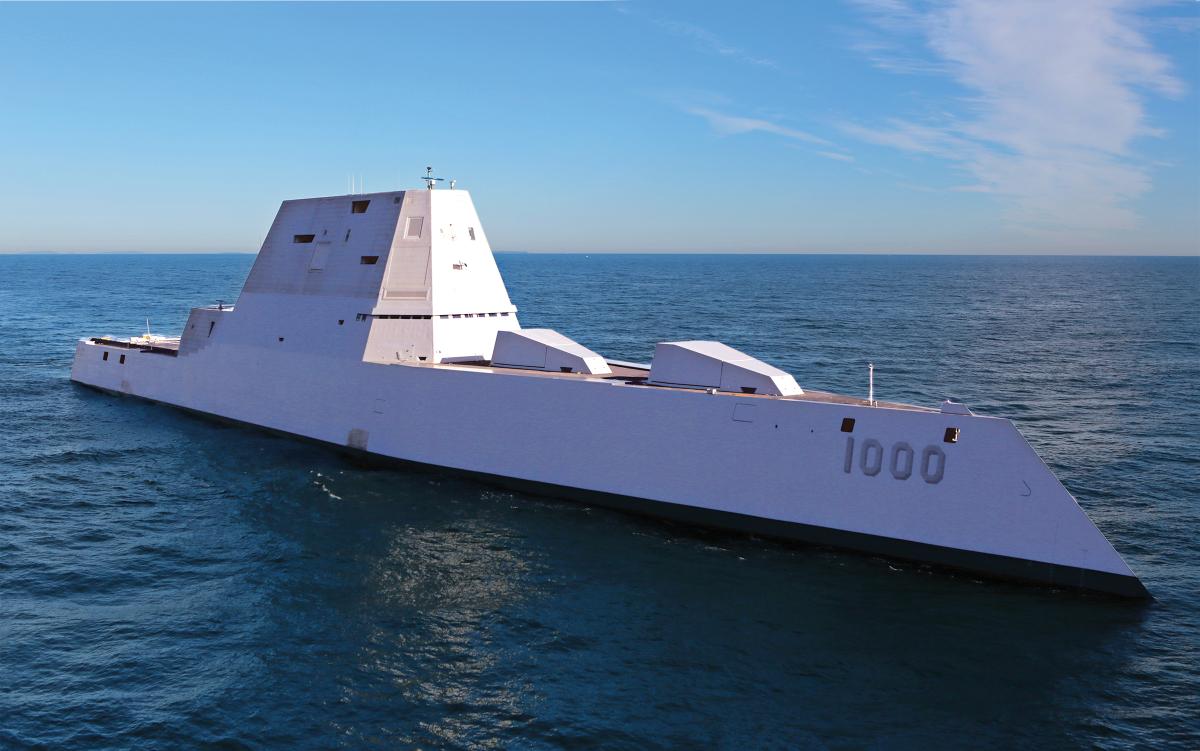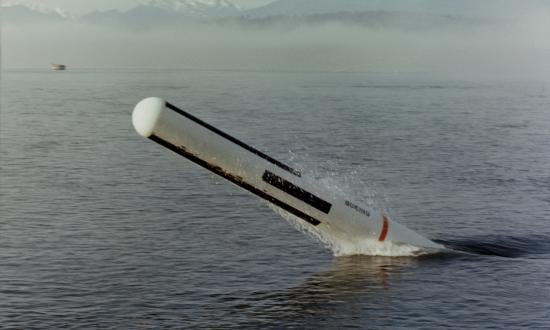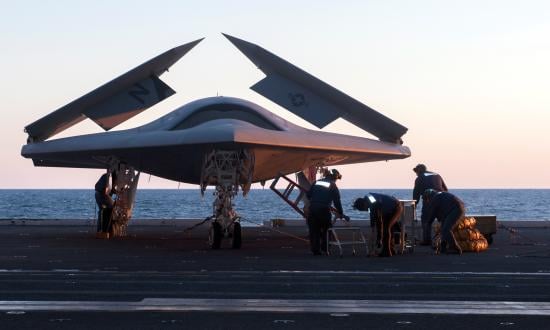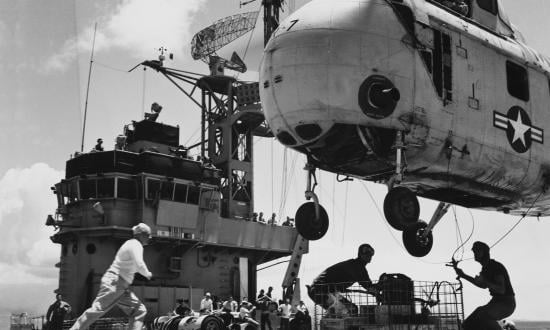Guns have been a mainstay of warships for almost 700 years. The gun revolutionized naval warfare, and mastery of naval gunnery led to the rise and fall of empires. Overtaken by airplanes and guided missiles in the 20th century, artillery has seen recent advances in technology that could once again make the naval gun the dominant form of firepower at sea.
The first known use of gunpowder-based cannon at sea was at the Battle of Arnemuiden in 1338. The English warship Christopher, armed with three artillery pieces, was able to hold off a larger French force (though the English eventually were defeated). Despite England’s loss, the battle was a watershed, sparking an arms race that spread first across Europe, then the rest of the globe.
Properly used, naval artillery could easily devastate a target. Solid iron cannonballs were useful against a wooden ship: Blasting holes in the wooden hull could sink it, smash its masts to disable propulsion, and send giant splinters flying about the decks. So-called grapeshot (clusters of small balls) essentially turned naval guns into shotguns, blasting the target with swarms of smaller balls that were lethal to the crew and ship’s rigging.
But shipboard guns did have problems. While increasing the size of a gunpowder charge could increase a gun’s range in principle, primitive metallurgy limited its ability to withstand high chamber pressures. With too big a charge, the gun could burst. Shipboard guns also were notoriously inaccurate, especially on rolling seas.
The range issue hobbled naval artillery for centuries, limiting traditional muzzle-loaded guns to effective ranges in the mere hundreds of yards. Industrial Revolution advances in metallurgy led to rapid strides. By 1910, the 12-inch guns of the battleship USS Wyoming (BB-32) could lob an 870-pound armor-piercing shell 6.8 miles. Just 31 years later, the 16-inch guns of the battleship USS Missouri (BB-63) could lob a 1,900-pound high-explosive projectile 23 miles—and do so at a sustained rate of two rounds per minute.
The problem of accuracy was addressed in several ways. Early warships, such as the first frigates of the U.S. Navy, packed many guns into a single warship to concentrate firepower. If a single gun had a low probability of hitting its target, many guns would increase the likelihood of landing at least some blows. Later developments included rifled gun barrels, which imparted spin to a departing round and stabilized it in flight. Later still, fire control became more science than art, thanks to mechanical computers, radar, and other advances that increased overall gun accuracy.
At the start of World War II, battleships were still the dominant form of firepower at sea. The United States, France, Italy, the United Kingdom, and Japan all had built large fleets of massive ships with 14-, 16-, and even 18-inch guns. Latecomer Germany, constrained for years by disarmament agreements, built battleships such as the Bismarck and Tirpitz (postponing aircraft carriers to a future date that would never come). All the major powers predicted that surface ships with big guns would again play a key role in the next war, with the new aircraft carrier in a supporting position.
The onset of war proved that prediction very wrong. While advances during the interwar period in carrier-based aircraft, particularly firepower and range, were obvious, it still came as a shock to many how quickly aircraft carriers displaced battleships. Carriers could deliver more firepower at greater ranges than battleships, without the ship itself ever exposing itself to the guns of its target. Battleships quickly fell out of favor, relegated to antiaircraft and naval gunfire support roles.
For the past 75 years, guns have continued to take a backseat, first to aircraft, then to missiles. The need for fire support of troops ashore led the Navy to briefly reactivate the Iowa-class battleships during the Korean and Vietnam wars, and in the 1980s the ships were refurbished for duty in the vaunted “600-ship Navy.” Unfortunately, the guns of the four battleships still were limited in range and accuracy to 1945 levels. The four ships were fitted with Tomahawk land-attack cruise missiles for long-range, precision strike and Harpoon missiles for the antiship role. But manpower-intensive and expensive to operate, the battlewagons were quickly retired at the end of the Cold War.
Today, the U.S. Navy operates just two main gun types—a rapid-fire 57-millimeter gun on board the littoral combat ships and the 5-inch/62 Mk 45 lightweight gun, fitted to Arleigh Burke–class guided-missile destroyers and Ticonderoga-class cruisers. Each cruiser has two 5-inch guns, while a destroyer mounts one. (Smaller guns such as the 30-millimeter Mk 46 Mod 2 Gun Weapon System are also in service.)
In the late 2000s, the Navy attempted to boost the fleet’s big-gun firepower with the new Zumwalt-class destroyers. Each Zumwalt carries two 155-millimeter Advanced Gun Systems, which were to have fired the Long Range Land Attack Projectile (LRLAP), a new, precision-guided artillery round with a range of 60 miles. Unfortunately, the cost of LRLAP skyrocketed (both for technical reasons and because of lost economies of scale after the number of destroyers was cut from a planned 32 to only 3), leading the Navy to abandon the shell and search for an alternative.
Despite the Advanced Gun System missteps, there are signs big guns could be making a comeback.
The Navy is currently testing two electromagnetic railguns, one built by BAE Systems and another by General Atomics. The system replaces volatile power-based explosives with high-energy magnets to accelerate guided projectiles with ranges from 50 to perhaps eventually 200 nautical miles. One benefit of the powderless system is that a ship equipped with it can store more rounds in its magazine than one with conventional guns.
A second emerging technology also promises to boost guns to ranges previously enjoyed by aircraft and missiles. The U.S. Army’s Strategic Long Range Cannon (SLRC) project seeks to design a gun capable of striking targets at ranges of up to 1,100 nautical miles. The Army has conceived of SLRC as truck-mobile—resembling the railroad cannons of previous wars—and capable of bombarding enemy targets with impunity at ranges comparable with those of intermediate-range ballistic missiles.
The Army envisions SLRC as a system that could be flown into place, trucked into a firing position, and then shell targets from maximum distance. In principle, mobile SLRCs operating from the island of Palawan, adjacent to the South China Sea, could methodically bombard China’s air and sea bases, without exposing carriers or their aircraft to Chinese missiles.
But such a deployment scheme limits the gun to operating from friendly territory and depends a great deal on the Air Force for deployment and sustainment.
The SLRC can reach its full potential by going to sea. From a position in the Indian Ocean, a ship equipped with SLRC could simultaneously reach targets in Somalia, Yemen, Iran, and Afghanistan. From a position well outside the first island chain, SLRC could bombard targets in North Korea, China, and even Russia’s Far East territories. This could provide invaluable support to allies in responding to a Chinese invasion of Taiwan or to a war on the Korean peninsula. Several monitor-like warships, connected through the Navy’s Project Overmatch battle networking system, could strike targets with the power of a carrier air wing.
The National Academies of Sciences, Engineering, and Medicine is conducting a feasibility study of the technology, but the Army appears to have great confidence in it. The service plans to test a prototype in 2023. If the gun works as advertised, it would have tremendous implications for long-range warfare, with the potential to replace or complement expensive missiles, drones, and combat aircraft with relatively inexpensive guided shells.
Naval artillery was the dominant weapon at sea for centuries, until it was suddenly upset by aircraft and missiles. Assigned to a supporting role for the better part of a century, the warship gun appears poised for a second chance at the top. If the railgun and the Army’s long-range gun project can become operational weapon systems, they could lead to one of the most unexpected comebacks in history.







